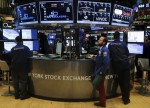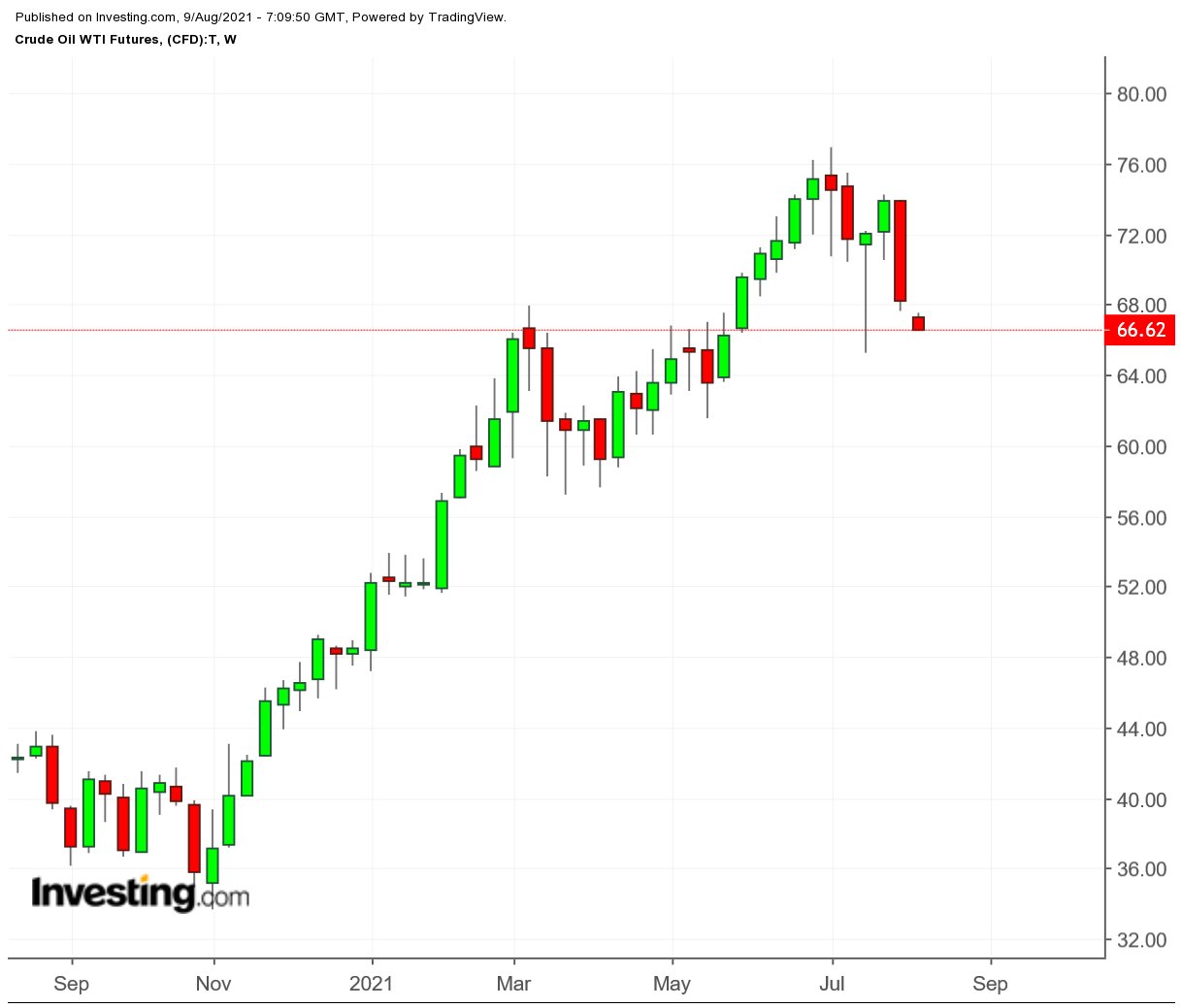
- All Instrument Types
- Indices
- Equities
- ETFs
- Funds
- Commodities
- Currencies
- Crypto
- Bonds
- Certificates
Please try another search

Commodities Week Ahead: Gold, Oil Vulnerable On Dollar Surge, New COVID Curbs

The dollar surging on expectations of a Federal Reserve taper of its long-running stimulus and COVID travel curbs out of China are resulting in a double whammy for commodities as the week begins, with gold and oil looking the most vulnerable.
At the time of writing, gold already had a rollercoaster day, with the front-month futures contract on COMEX falling briefly to under $1,680 an ounce in Asian morning trade, before pulling back to around $1,740 by noon. The rebound aside, gold was still down 1.4% by noon in Singapore or midnight in New York.
Monday’s break beneath the $1,700 threshold could entertain gold bears into taking another stab at the sub-$1,680 levels, gold chartist Anil Panchal wrote in a blog post on FX Street.
But if gold continues to recover, then the progressive levels will be $1,790, followed by $1,804 and $1,815, Panchal said.
He added:
“While US dollar consolidation and recovery in the market’s risk appetite seems to have triggered the gold price rebound, the bears remain hopeful amid the Fed’s tapering concerns and COVID woes.”
Since January, gold has been on a tough ride that began in August last year—when it came off record highs above $2,000 and meandered for a few months before stumbling into a systemic decay from November, when the first breakthroughs in COVID vaccine efficiencies were announced.
At one point, gold raked a near 11-month bottom at under $1,674. After appearing to break that dark spell with a bounce back to $1,905 in May, gold saw a new round of short-selling that took it back and forth between $1,700 and $1,800.
Oil In A New Normal: Lower
Oil, which has been the star of the commodities complex since US COVID vaccinations took off in a big way, and OPEC+ production cuts began to bite, took a harder hit than gold.
Both New York-traded U.S. West Texas Intermediate crude, the benchmark for U.S. oil, and London-traded Brent, the global benchmark for oil, were down about 2% each by noon in Singapore.
Trading beneath $70 a barrel is a new normal for WTI and Brent, which have fetched prices well above that mark over the past two months.
Last week’s 7% loss on the two crude benchmarks extended on Monday as the dollar hit four-month highs versus the euro. Adding to that were concerns about new COVID-related curbs in Asia, especially in China, that stoked worries about a setback in global fuel demand.
China, the world's second largest oil consumer, cancelled a horde of flights and issued warnings against travel in 46 cities, and limited public transport and taxi services in 144 of the worst COVID-hit areas.
ANZ commodity analysts said in a note about the renewed risk to oil demand from the Delta variant of the virus:
"While the number of cases (in China) is low, it comes just as the summer travel season peaks. This has overshadowed signs of strong demand elsewhere."
‘Twin Evils’ To Gold
Adding to the dollar’s weight on gold was the rise in the 10-year Treasury yields, which signaled an oncoming hawkish stance by the Fed. The dollar and the 10-year note can be described as the “twin evils” to gold, with their combined rally often delivering a fatal blow to long positions in gold.
Against a background of a resurgence of the pandemic, reports on US consumer and producer price inflation will likely dictate risk markets for the week, including in commodities.
An upbeat U.S. jobs report for July that cited the creation of nearly a million new jobs appears to have become a game-changer in how the Federal Reserve proceeds with its monthly stimulus of $120 billion to the economy and markets.
FedSpeak This Week
On the Fed’s end, several of its top-notch officials are slated to speak this week and their comments could help clarify the central bank’s position on the so-called stimulus tapering.
Among the Fed officials with speaking engagements are Atlanta Fed President Raphael Bostic and Richmond Fed head Thomas Barkin on Monday, Chicago Fed President Charles Evans on Tuesday and Kansas City Fed President Esther George on Wednesday.
Bostic and Barkin are known to lean towards tapering, so their comments will be closely watched.
Fed And Jackson Hole: The Top Agenda Setters For Markets Now
The bar the Fed set for scaling back its bond-buying program—"substantial further progress" toward the Fed's 2% inflation and full employment goals—has never been precisely defined.
In June, officials began debating on how soon the central bank can begin to ease back on its emergency support for the economy, even amid the emergence of the Delta variant.
The upbeat jobs numbers coupled with uncomfortably hot inflation data could prompt Fed officials to announce plans to begin tapering bond purchases as soon as September, the first step down the road to eventual interest rate hikes.
Friday’s stronger-than-expected July jobs report was the last before the Fed gathers for its annual meeting in Jackson Hole, Wyoming, between Aug. 26 and 28, to discuss policy and decide future stimulus strategy.
Amid this week’s Fed chatter, the U.S. consumer price index and the producer price index, due Wednesday and Thursday, respectively, will provide an insight into the current pace of inflation, one of the key factors along with the labor market, that the Fed looks at when making its monetary policy decisions.
CPI is expected to moderate slightly after last month’s jump of 0.9%, the strongest gain since June 2008. The Fed has said the current surge in inflation is just temporary, but market sentiment has been hit by fears of higher inflation resulting in a sudden tapering.
Disclaimer: Barani Krishnan uses a range of views outside his own to bring diversity to his analysis of any market. For neutrality, he sometimes presents contrarian views and market variables. He does not hold a position in the commodities and securities he writes about.
Related Articles

I recognize that there is a good case for gold at a time when the price level is rising steadily and there are upside risks to inflation and downside risks to the dollar. Let me...

Upon analysis of the wobbly moves since Tuesday, when the natural gas futures tested the two-year high at $4.55, Thursday might be a cozy one, as the inventory announcements after...

Energy prices remain under pressure amid demand concerns, while copper prices get a boost from tariff uncertainty Energy- Brent Breaks Below $70/bbl Sentiment remains negative in...
Are you sure you want to block %USER_NAME%?
By doing so, you and %USER_NAME% will not be able to see any of each other's Investing.com's posts.
%USER_NAME% was successfully added to your Block List
Since you’ve just unblocked this person, you must wait 48 hours before renewing the block.
I feel that this comment is:
Thank You!
Your report has been sent to our moderators for review







Add a Comment
We encourage you to use comments to engage with users, share your perspective and ask questions of authors and each other. However, in order to maintain the high level of discourse we’ve all come to value and expect, please keep the following criteria in mind:
Perpetrators of spam or abuse will be deleted from the site and prohibited from future registration at Investing.com’s discretion.